Bryan Pearson's Blog, page 45
July 10, 2013
July 10: Loyalty Links & Likes
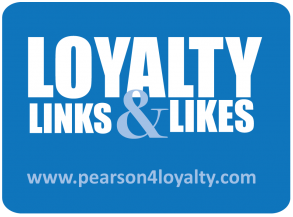 Here are a few loyalty links that caught my eye this week.
Here are a few loyalty links that caught my eye this week.
1. 6 Reasons to Opt for Card-Linked Loyalty Programs — Street Fight Magazine
Why loyalty providers should consider connecting their programs to customers’ credit, debit cards.
2. Where Do Customer Loyalties Really Lie? — Retail Wire
Features numbers and insights from the 2013 COLLOQUY Loyalty Census.
3. Customer Rewards Benefit Retailers, Too — Star Herald
How retailers are relying on loyalty program data to boost their bottom line.
4. Rogers First Rewards to Launch in Key Markets This Summer — COLLOQUY
Rogers Communications’ new loyalty program allows for point accrual, redemption.
5. Loyalty Cards Not Going Away — Boston Herald
Despite some retailers’ decisions to do away with their loyalty cards, a trend is unlikely.
July 9, 2013
Hot Off the “Press”: The Loyalty Leap for B2B
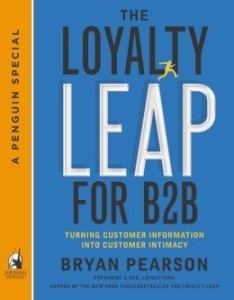 After half a year of planning and writing, countless rewrites and many executive interviews, my second book, The Loyalty Leap for B2B: Turning Customer Information into Customer Intimacy, has hit the e-shelves.
After half a year of planning and writing, countless rewrites and many executive interviews, my second book, The Loyalty Leap for B2B: Turning Customer Information into Customer Intimacy, has hit the e-shelves.
I began thinking of a sequel to my first book, The Loyalty Leap: Turning Customer Information into Customer Intimacy, soon after it was published in May 2012. This is because during the course of my travels, during which I spoke frequently about creating customer intimacy through responsible data use, a lot of executives asked me how they could apply the same principles in a business-to-business context.
So in late 2012 I decided to put thought to paper again. Or, to be more accurate, I put thought to e-paper. The Loyalty Leap for B2B is an e-book that applies my key principles of the Loyalty Leap, along with six critical steps for building a loyalty initiative, across three business segments: small businesses, large enterprises and channel marketers. I also share some thought-provoking case studies that demonstrate these steps by industry leaders, including American Express, Teradata, Premier Healthcare Exchange and salesforce.com.
What exactly is the Loyalty Leap? I define it as using data to build emotional loyalty. That means placing the customer above product, service and profit and basing every company decision on what is relevant to that customer, using the shared data. Organizations that are customer-committed stand apart from their rivals because they connect with customers on an emotional level.
Can the B2B sector make the Loyalty Leap? It can, and it wants to. It simply has to understand how to use the available tools to build a loyalty or customer-engagement program that will help business clients achieve specific goals.
The Loyalty Leap for B2B is available at:
Amazon.com
Barnes and Noble
Bookish
iBookstore
Google play
Kobo
July 3, 2013
July 3: Loyalty Links & Likes
 Here are a few loyalty links that caught my eye this week.
Here are a few loyalty links that caught my eye this week.
1. A Restaurant Built (and Rebuilt) With Customer Loyalty — Entrepreneur
How Red Hook Lobster Pound keeps its customers coming back to the table.
2. Jewel folds its loyalty card as others struggle to win rewards game — Chicago Tribune
Unable to capitalize on its data, the grocery chain cuts loyalty program.
3. TV Transformation: How customer data saved Netflix — COLLOQUY
Company uses years of customer data to improve product through content and technology.
4. Loyalty points: Don’t waste this overlooked asset — The Globe and Mail
What happens to an individual’s loyalty points and travel miles when he or she dies? Why some should consider point bequeathment.
5. Loyalty Programs Muscle Into New Industries — Media Planet
The 2013 COLLOQUY Loyalty Census shows loyalty program growth and opportunity.
June 27, 2013
June 27: Loyalty Links & Likes
 Here are a few loyalty links that caught my eye this week.
Here are a few loyalty links that caught my eye this week.
1. Read Books, Earn Points: A Publisher Unveils a Rewards Program — TIME
The Penguin Group (my book publisher) has adopted a rewards program to thank loyal customers.
2. Partnership Poker: Betting on loyalty program alliances — COLLOQUY
How brands leverage the power of partnerships to create engaging loyalty programs.
3. Customer loyalty gets just reward — Albany Times Union
A food co-op is expanding to cater to its loyal customers.
4. Convenience Store Loyalty on the Skids? — CSPnet.com
Story features data from the 2013 COLLOQUY Loyalty Census and discusses how c-store loyalty program participation is on the decline.
5. Fast-Food Chains Miss Out on Sales as Customer Loyalty Lags — The Wall Street Journal
A recent study shows better customer service in restaurants can lead to higher sales growth.
June 25, 2013
Albertsons Exits Loyalty, Slips on Data Opportunity
 One of the occupational hazards of operating a loyalty program based on providing preferential pricing is that at some point you end up giving the preferred pricing to everyone. That is the problem that Albertsons recently wrestled with, and seemingly pinned down, when it announced it was cancelling its Preferred Card loyalty program. According to the company, everyone has the card, so it decided to take the “special step” of not requiring one anymore. It calls the new approach “Card Free Savings.”
One of the occupational hazards of operating a loyalty program based on providing preferential pricing is that at some point you end up giving the preferred pricing to everyone. That is the problem that Albertsons recently wrestled with, and seemingly pinned down, when it announced it was cancelling its Preferred Card loyalty program. According to the company, everyone has the card, so it decided to take the “special step” of not requiring one anymore. It calls the new approach “Card Free Savings.”
“Our customers are the only reasons that our doors open every day,” the company explained on its website. “Because of you, we exist. It’s that simple. We feel it’s our job to give everyone a great shopping experience, and that includes offering great prices to everyone.”
Sure, everyone loves great prices, but what about the information consumers shared in return for participating in the loyalty program? One of the purposes of loyalty programs is to gain the insights to inform better decisions about merchandising, locations, pricing and hours – not just promotions. It is all part of elevating the customer experience.
This is what so many marketing heads were worried about so long ago. Two-tiered pricing models for loyalty are not competitively differentiating unless they are applied at the individual level. And when executed as mass programs, they especially won’t work when you can go to Walmart without a card and get the same prices or better.
True, Albertsons’ decision is not surprising if everyone is getting the same discount and you’re looking to make the experience easier for the customer. But it is shortsighted from a customer data perspective, and it ultimately may lessen the company’s ability to fully understand its customers and their behaviors – and this may impact its ability to engage them in the future.
June 24, 2013
Loyalty 360: Ctrl Alt Delete: Q&A with Social Media Expert Mitch Joel
By: Bryan Pearson, LoyaltyOne • 1360 views
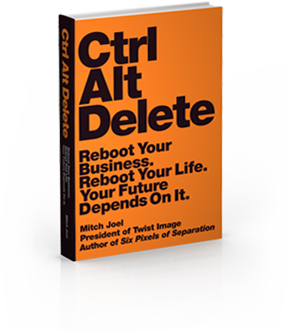 When the loyalty expert sits down with the social media guru, everything we thought we knew about digital engagement is rebooted. Bryan Pearson, CEO of global loyalty marketing firm LoyaltyOne, interviews online authority
Mitch Joel
for a Q&A on how to build emotional loyalty in the digital world. Joel, bestselling author and president of leading digital marketing agency
When the loyalty expert sits down with the social media guru, everything we thought we knew about digital engagement is rebooted. Bryan Pearson, CEO of global loyalty marketing firm LoyaltyOne, interviews online authority
Mitch Joel
for a Q&A on how to build emotional loyalty in the digital world. Joel, bestselling author and president of leading digital marketing agency
Twist Image released his latest book, “CTRL ALT Delete,” on May 21 and Bryan Pearson’s newest book “The Loyalty Leap for B2B” will be available in early July.
Reaching consumers today may seem less a matter of human decision-making than digital science. Algorithms help us to identify consumer segments, while consumers adapt to new technologies and lifestyles faster than we can create an app for them.
The DNA of the business world has changed, some say. Fortunately, my friend Mitch Joel is the marketing geneticist who could unravel the reasons why and help us evolve beyond the change.
Joel released his latest book, “CTRL ALT Delete” on May 21. He took a little time from his busy travel schedule to talk about his upcoming book, the importance of workplace infrastructure and business purgatory.
Q: What do you mean by your book title, “CTRL ALT Delete”?
I spend a ton of time with executives from all over the world and from all business sectors, and when I talk about how they connect with consumers, there’s this uniformed chant of, “We feel like we’re still in hell.” But from my perspective of running a digital marketing agency, we’re in purgatory. Hell is when senior executives would say, “So Mitch, tell me why I need a website?” This was 15 or 20 years ago and they didn’t know if the web was a fad or not. Fast forward to today, and they’re asking, “Should I be doing mobile, should I be doing social, what should I do to bring loyalty into the mix? How do I make that all happen?” We don’t see these technologies as a fad anymore.
So in my brain, “CTRL ALT Delete” was a euphemism to reboot – to think differently about business and how to adapt to the fundamental shifts that have already occurred.
Q: In the book, you describe a brand’s presence in social media as an intrusion. How can a brand use Facebook or other social platform to create genuine loyalty?
The reason I speak of it as an intrusion is because brands didn’t initially see social media as an opportunity to connect with real human beings. They were dragged into it kicking and screaming because people were complaining about the brand, and so the brands had to react. Brands still struggle with how to engage. But the simple reality is that the average person on Facebook has, I think, 200 connections. If you’re under 18 it’s closer to 500. That’s a tight social unit. So how do you penetrate that? You have to create something that is going to be of value, and you have to create utility with features that indirectly connect the consumer to the brand. It has to be something people can use or you just contribute to fatigue.
Q: All of these forms of existence – digital and physical – can result in brand saturation. Do you have any examples of brands using a digital presence to ensure loyalty instead of add to the noise?
One of my favorite examples is an app called “SitOrSquat.” Turn the app on anywhere in the world and it will show you where to find a clean bathroom. You can rate the bathrooms, comment on them, add a bathroom, or request that a bathroom be removed. You could even find out if a bathroom has a changing table. And it’s all brought to you by Charmin, the toilet paper company owned by Procter & Gamble. So now when I go strolling through the aisle at Walmart, instead of tipping a 32-roll, $9.99 package of any toiler paper into my shopping cart, I‘ve become a Charmin evangelist. And the best thing is the app doesn’t displace traditional advertising or coupons; it adds to the utility. And these types of utilities actually transcend the digital realm to enter the physical world.
Q: Your book is divided into two areas, with one focusing on rebooting the organization and the second on rebooting the individual. Tell me about the latter.
“CTRL ALT Delete” addresses five massive movements that have changed everything we know about business. The reason I wrote the second part of the book, called “Reboot: You,” is because regardless of these fundamental changes, we need to examine how we react as individuals. I am hiring people for jobs that didn’t even exist when I started this business. Imagine what the disruption of these movements means going forward. We’re going to be creating new industries, new opportunities. At the core of that we have to figure out how we – as employees, as employers, as entrepreneurs – operate in that dynamic environment.
Q: If you could narrow the “must-do” list to three, what steps would you advise organizations to take in order to become digitally effective?
First, create spaces that encourage multidisciplinary collaboration. You might have a front-end developer who has a really good, strategic mind. By limiting him to front-end development you aren’t using his whole brain. You want an environment that reveals what is happening in other departments. Conversely, there are introverts, people who need areas to work and think as well. So you need to create physical spaces that accommodate both types of workers.
Two, I think vision comes from the top. The evangelists are everywhere, so we have to empower our teams to understand the social media guidelines and what is expected in the public space. We hear about the negative instances, but the best stories are actually the positive ones, when workers know what they can and should do to make the business better.
Third, embrace people who bring professional diversification to the business. We use to look at a resume and think, “Wow, this person jumps around a lot.” But if I see they jump a lot because they’ve had a good beginning, middle and end, then I’m all for it. It’s fanciful to think that we’re going to get the gold watch after sitting in the same job for 40 years.
These three steps break the dogma a little, but we live in very different times.
Q: Mitch, what is your motto today?
In a nutshell: test small. We tend to think of business as requiring bigger moves. But testing small things every day will lead you to the bigger opportunities. And it will result in a better customer experience.
New Study Shows Enterprise Loyalty Delivers More Bang for Buck
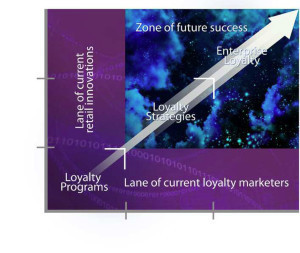 You don’t have to be an Einstein to understand what is important to your target customer, but understanding the relativity between the customer’s experience and long-term loyalty does take some sharp thinking. And it can make a double-digit difference in sales.
You don’t have to be an Einstein to understand what is important to your target customer, but understanding the relativity between the customer’s experience and long-term loyalty does take some sharp thinking. And it can make a double-digit difference in sales.
These are the findings of a recent report by COLLOQUY called The Big Bang Theory of Customer Centricity. Among its findings: Companies that practice Enterprise Loyalty can see their revenue increase by as much as 20 percent. The report highlights five companies that demonstrate these capabilities: Caesars Entertainment, Qantas, the financial services company USAA, the British grocer Tesco, and South African retailer Woolworths.
When you think about it, this makes perfect sense. Does the frontline employee know how often a particular consumer shops with your company? Do the site planners know from data insights how far your regular customers drive to shop at your locations? Do the folks in merchandising realize that the stores in college towns should stock smaller packets of fresh meat and produce, because the average households are smaller?
All of these insights can be gained through the practice of Enterprise Loyalty – the sharing of customer data beyond the marketing department, where it has traditionally been held. But adopting Enterprise Loyalty might require a philosophical shift in operations.
For many companies, the standard thinking has been that loyalty program data, as a marketing tool, should be sequestered in the marketing department. But in reality, all departments of an organization, from finance to legal to merchandising, can benefit from these insights because they reveal what is relevant to the consumer. And the consumer will benefit as well, in ways that are evident.
How do customers respond to Enterprise Loyalty practices? According to the report, companies in the early stages of an Enterprise Loyalty strategy can experience an 8 to 10 percent bump in revenue. Over three to five years, that gain will increase up to 20 percent. Here’s how that longer-term sales increase breaks down:
-A 2 to 4 percent increase from promotion optimization;
-3 to 5 percent increase from pricing optimization;
-1 to 3 percent increase from assortment optimization;
-3 to 5 percent increase from improved customer experience;
-and 1 to 3 percent increase from employee productivity.
These gains are real, and they can represent a material difference in a company’s return on investment. By overlaying a variety of data and then using those insights to understand the customer’s needs and aspirations, a company can create the types of experiences that result in rewarding relationships.
That’s the first step toward customer commitment. And it’s not just a theory – it is the way to operational and financial success.
June 20, 2013
June 20: Loyalty Links & Likes
 Here are a few loyalty links that caught my eye this week.
Here are a few loyalty links that caught my eye this week.
1. From Kroger to PSK Supermarkets, Retailers Big and Small Are Acing Loyalty Game — Supermarket News
The editorial features data from the 2013 COLLOQUY Loyalty Census and shares lessons for loyalty industry leaders.
2. Customers Willing to Pay for a Smile — Fox Business
A new study finds that one-third of shoppers return to stores because of great customer service.
3. Entrepreneurs Get Creative With Loyalty Rewards — USA Today
The reporter explores the world of loyalty marketing for small businesses.
4. Study shows airlines don’t rank high in customer satisfaction — Chicago Tribune
A break-down of why flyers are unhappy — Low quality loyalty programs make the list.
5. Target’s REDcard revs up sales — MPR
A look into Target’s rewards program and why it’s paying off for both company and consumer.
June 17, 2013
Loyalty Limelight: Walgreens Steps with Balance Picks Up Rewards Pace
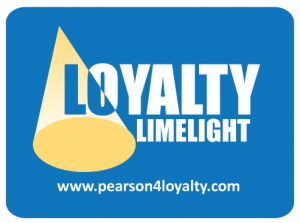 The program: Walgreens Steps with Balance Rewards
The program: Walgreens Steps with Balance Rewards
In a nutshell: Walgreens in the spring launched Steps with Balance, an enhancement to its Balance Rewards Program, as a healthy-living incentive. The initiative grants points to members for walking, running, and weight management – 20 points for each mile logged and 20 points when a member records his or her weight at Walgreens.com/balance-steps. Points can be redeemed for pretty much anything in the store (prescriptions and dairy products excluded for regulatory reasons).
New Features: Steps with Balance Rewards goes beyond the gym-coach approach because it’s self-directed. In addition to earning points for certain activities, Steps with Balance members can also gain points for setting personal goals or by linking their membership to a wireless tracker, such as Fitbit, Withings and BodyMedia (Withings also offers wireless scales).
But what really elevates Steps from a “Drop and give me 20!” program is its important social component. The program is designed as a community initiative and encourages members to link up and share stories. Some members create walking teams, and the community members support each other as they strive to reach their individual goals.
The Takeaways: In loyalty marketing, the most competitive rewards portfolios are those that mix both hard and soft benefits, meaning something tangible (points, miles or discounts) with something experiential (an event or special service). The Steps with Balance Rewards Program, in addition to granting points, taps into the soft benefits reserve twice – first by rewarding members for improving their health and second by encouraging them to create or join a supportive community. This layering of recognition, and reward-earning opportunities, builds a foundation for increased involvement and long-term commitment.
Other distinguishing features:
—Walgreens made a strategic choice to launch the program among its employees first. As a result, they are intimately familiar with how it works and have become ambassadors.
—In addition to rewards, members earn badges that recognize personal progress as reflected in their community profiles.
—The Steps with Rewards dashboard includes an “events” feature that lists community races and similar activities, searchable by zip code.
These features demonstrate that Walgreens has taken a measured approach to creating a program that anticipates needs, and one that can be easily built upon. I look forward to the day when Steps with Balance offers a gamification component. It is not there yet, but I’ll be waiting with my sneakers on.
June 12, 2013
June 12: Loyalty Links & Likes
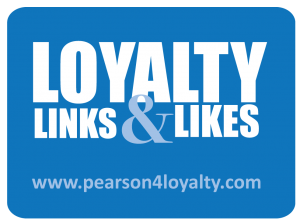 Here are a few loyalty links that caught my eye this week.
Here are a few loyalty links that caught my eye this week.
1. GM goal: Loyalty on the lift — Automotive News
General Motors is offering free maintenance for some of its newer models in the hopes of winning customer loyalty.
2. No-Fun Money: Enough Already With Tech Companies’ Currencies — Bloomberg Businessweek
Why company currencies mirror loyalty systems and how Amazon is trying to capitalize.
3. Cover Story: Are You a Social CRM Native — Target Marketing
The reporter explores the role social media plays in customer relationship management (CRM).
4. LOC Card to replace the need for store loyalty cards — Soapbox Cincinnati
A startup has created a universal loyalty card allowing customers to manage all loyalty program memberships in one place.
5. Amazon targets frequent shoppers with new Prime service — Reuters
The world’s largest online retailer is trying to attract more-frequent shoppers with new grocery delivery service AmazonFresh.
Bryan Pearson's Blog
- Bryan Pearson's profile
- 4 followers



